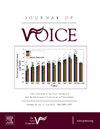High-Speed Image Analysis Comparing Loading of Vocal Folds During Coughing and Phonation: A Case Study
IF 2.4
4区 医学
Q1 AUDIOLOGY & SPEECH-LANGUAGE PATHOLOGY
引用次数: 0
Abstract
Purpose
Coughing is related to voice problems, since it involves firm glottal closure, fast glottal opening, and high subglottic pressure and flow rate. In this study, the glottal area variation and movements of laryngeal structures during coughing and phonation are compared.
Methods
High-speed laryngoscopy recordings were made of a normophonic male participant with a healthy larynx producing a neutral vowel and coughing. Oral air pressure was registered in a mouthpiece, through which an endoscope was inserted into the pharynx. Electroglottography, acoustic, and pressure signals were recorded simultaneously. The glottal width variation at the membranous and cartilaginous parts of the glottis was derived from the high-speed images, and the strong vibration of the false vocal folds was also registered.
Results
In coughing, compared to ordinary vowel phonation in nearly the same sound pressure level (93–94 dB6cm), the glottal width was 25% larger at the middle of the vocal folds, the maximum glottal opening velocity was 39% higher, and the maximum glottal width declination rate during glottal closing was up to three times higher. The maximum acceleration was 40% higher, and the maximum deceleration was 47% higher. Fundamental frequency f0 was the highest (ca. 400 Hz) at the beginning of the first phase of a typical coughing process. During the last part of the coughing process, f0 decreased from ca. 250 Hz to ca. 85 Hz at the phonation offset.
Conclusions
The remarkable increase in maximum glottal width declination rate implies much higher vocal fold loading in coughing compared to phonation.
比较咳嗽和发声时声带负荷的高速图像分析:个案研究
目的:咳嗽与声音问题有关,因为它涉及声门关闭牢固,声门打开快速,声门下压力和流速高。在这项研究中,比较了声门区域的变化和喉部结构在咳嗽和发声时的运动。方法对正常发声的男性受试者进行高速喉镜检查,记录其正常喉部发出中性元音并咳嗽。口腔气压记录在一个吹口上,通过这个吹口将内窥镜插入咽部。同时记录声门电图、声学和压力信号。声门膜部和软骨部的声门宽度变化来源于高速图像,假声带的强烈振动也被记录下来。结果在几乎相同声压级(93 ~ 94 dB6cm)下,咳嗽时与普通元音发声相比,声道中部声门宽度增大25%,声门最大开启速度增大39%,声门关闭时声门最大宽度衰减率增大3倍。最大加速度高40%,最大减速度高47%。在典型咳嗽过程的第一阶段开始时,基频f0最高(约400 Hz)。在咳嗽过程的最后一部分,f0在发声偏移处从约250 Hz下降到约85 Hz。结论最大声门宽度下降率的显著增加表明咳嗽时声带负荷比发声时高。
本文章由计算机程序翻译,如有差异,请以英文原文为准。
求助全文
约1分钟内获得全文
求助全文
来源期刊

Journal of Voice
医学-耳鼻喉科学
CiteScore
4.00
自引率
13.60%
发文量
395
审稿时长
59 days
期刊介绍:
The Journal of Voice is widely regarded as the world''s premiere journal for voice medicine and research. This peer-reviewed publication is listed in Index Medicus and is indexed by the Institute for Scientific Information. The journal contains articles written by experts throughout the world on all topics in voice sciences, voice medicine and surgery, and speech-language pathologists'' management of voice-related problems. The journal includes clinical articles, clinical research, and laboratory research. Members of the Foundation receive the journal as a benefit of membership.
 求助内容:
求助内容: 应助结果提醒方式:
应助结果提醒方式:


